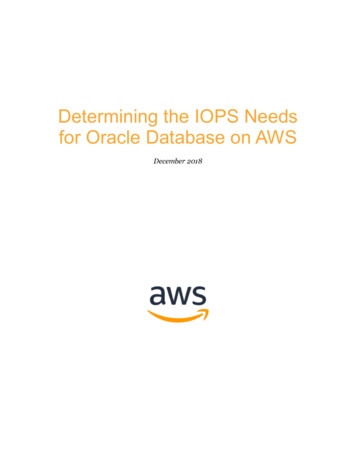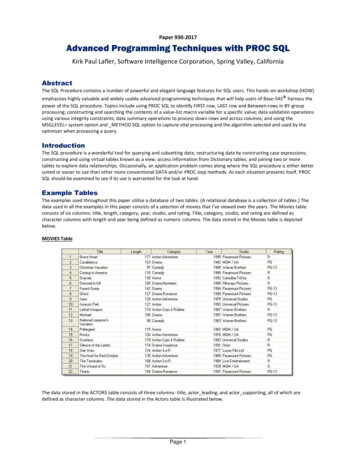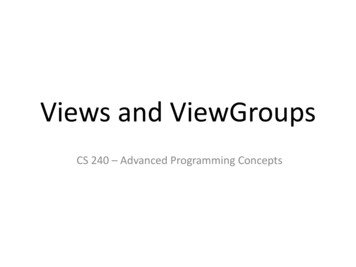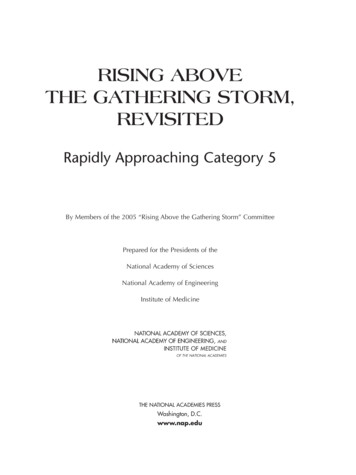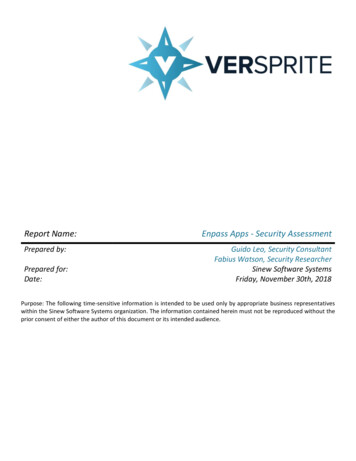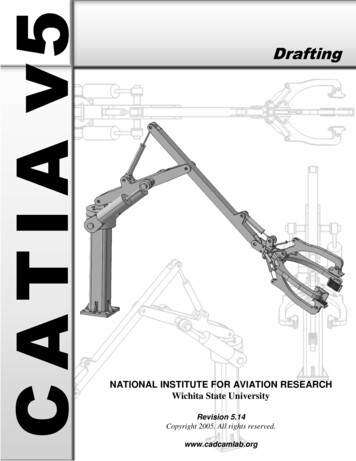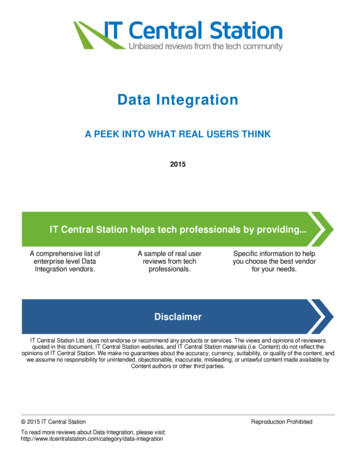
Transcription
Tools for gathering theviews of children andyoung peopleMay 2020www.highland.gov.uk
Gathering the views of children and young people2
Does this heading look familiar?Child/Young person’s views (must be completed)It’s that tricky section in the Child’s Plan which for some children/young people with complex needs canseem a difficult if not impossible task to complete. More and more we are being encouraged to gather theviews of children/young people with Additional Support Needs (ASN) around their likes and dislikes,emotions and feelings, friendships and things that matter to them.This document includes some tools and strategies which might help to ensure that we are gathering thechild/young person’s views and giving them a voice not only during the Highland Practice Model processbut thinking beyond the Child’s Plan.Here is a selection of ideas which may be useful, but it is by no means an exhaustive list. Ensure to matchthe strategy to the child/young person’s strengths, interests and communication and developmental level.*Disclaimer: Some commercial tools are included within this document. These are tools that are used from time to time bycolleagues. Their inclusion does not constitute a recommendation to purchase these tools.What does legislation say about this?Under the United Nations Convention on the Rights of the Child (UNCRC) all children, including those withASN and disabilities, have the right to have their views sought and expressed.UNCRC Article 12 (respect for the views of the child) - Every child has the right to express their views,feelings and wishes in all matters affecting them, and to have their views considered and taken seriously.UNCRC Article 13 (freedom of expression) - Every child must be free to express their thoughts and opinionsand to access all kinds of information, as long as it is within the law.This can be challenging particularly for very young children as well as for children/young people withbarriers to communication - hopefully some of the following tools will help.Involving children/young people in meetingsThis can be a positive experience for the child/young person and family,but it can also be a tricky one to manage, depending on their needs. Weshouldn’t assume that the child/young person can or can’t attend and itmay be just for part of the meeting but think carefully about how theymight react and the difficulties for parents trying to focus. Discuss andagree the best approach with the parents and child/young person,where appropriate, as part of preparing them for the meeting.Alternatively At a meeting share photos/video of the child/young person: coming into the setting/class, in the setting doing something they enjoy or in their safe space;working on one of their targets and include a comment beside it in their voice;extracts, photos and comments from their Profile or class work; andengaged in out of school activities.Gathering the views of children and young people3
Solution focused meetingsA multi-agency group meets to consider how best to support the needs of specific pupils. The solutionfocused meeting will focus on solutions and include parents’ and children/young people’s views.Solution Focused Meeting Information LeafletWhat can you do?Become familiar with the various methods and tools mentioned below. Discuss with parents, carers andprofessionals which might be the most suitable to match to the child/young person’s strengths. Some ofthe approaches require an investment of time but you may get better results each time you use them.Start small, try one out and see what works best.Use familiar adults to help gather this informationTalk to parents/carers, school staff and other professionals involved about what works well for thechild/young person and what they feel they enjoy doing best. This information can be used to feed into thewider picture of a child/young person’s life. Familiar adults can be particularly useful for gatheringinformation about children and young people with complex needs and can be used to complete the“child/young person’s view” section of the plan.Things to consider:How do children/young people respond to different experiences and environments?How do people know this?What do they enjoy?Is there an impact on their stress or alertness levels and in which situations?Within the education setting you could comment on how children/young people respond when: they put on their uniform/sweatshirt;parents/carers pick up their “back pack” or “snack box”;they see the building, their friends or staff as they arrive;they are with their friends;they are in class and with staff; andduring break times.Outside the education setting you could comment on how children/young people respond to: play activities, interests, hobbies, being alone or with friends;activities and environments outside thehome;achievements have they made; andsocialising with their family and the socialcircle beyond.Gathering the views of children and young people4
ObservationsObservations* can be used to notice children and young people’s behaviours and reactions to certainsituations, activities or events. Observations can help to provide information on: what they like or dislike;how they express their feelings;what soothes or settles them;what upsets, stresses or overexcites them;whether they look to an adult for a safe base;how they look when near staff or other children/young people e.g. relaxed, fidgety, uncomfortable;their primary response to stressful situations (fight, flight or freeze);engagement/disengagement with certain tasks/subjects;peer relationships; andstrategies that children/young people use to help themselves.Observations are best carried out over multiple sessions, at different times of the day and week, as anynumber of factors may be impacting on how a child or young person may present at a certain time. Anyassumptions made about how they might feel should be checked out with them as much as possible. Forpupils who may find it difficult to answer questions verbally, assumptions could also be checked out byusing some of the other techniques suggested in this document (e.g. Faces - Likert Scale; Blob Trees; TrafficLights).*Please note, ethical questions will arise when observing a child/young person, and these should be fully considered beforeproceeding.“Intensive Interaction” type strategies used in play promote positiverelationships by focusing on the foundations of early interactions:being attentive, showing interest, anticipating, sharing, turntaking, trust and respect. This practical approach can beparticularly useful in building up a relationship leading to a greaterawareness of what matters most to the child/young person – theirvoice.For more information see:Wesley Tingey on UnsplashUsing an “Intensive Interaction” type approachSELFIE StepsResponsive CommunicationEASEYS for ASN Intensive InteractionUsing puppetsA child/young person who may have difficulty with face to faceconversation with an adult might relate better to a puppet. They may followthe puppet’s instructions or talk back to it or just feel more comfortablewith the puppet there.See Resilient Kids to School for some ideas on using puppets to supportactivities around emotional literacy and resilience.Gathering the views of children and young people5
Pen portraits“Ways YOU can help ME”A “Ways YOU can help ME” sheet, written in the child/young person’s voice, can provide an easilyaccessible way of sharing information within the setting on the targets and practical strategies which helpsupport them.“All About Me” booklets and personal communication passportsFor some children/young people more information is needed due to the complexity of their ASN. The mainreason for creating these types of booklets is to gather complex information together and present it in aneasy to read format. This ensures that all relevant information is easily accessible and in one place forthose who need to read it. It is a way of sharing the child/young person’s voice for those who cannot easilyspeak for themselves. The booklet should be person-centred, written in their voice, and tailored to theirunique profile. They can be used to support transitions into Early Learning and Childcare settings, school,between classes and settings and towards post school destinations.Reference to these documents could be made in the “Child/Young Person’s views” section of the Child’sPlan. For more information see EASEYS for ASN Vertical Transitions or CALL Scotland PersonalCommunication PassportsDrawing pictures/taking photographs/using symbolsChildren/young people can be supported to draw pictures, take photographs or choosesymbols as a way of sharing their views. They could be asked to draw/photograph theirfavourite things; favourite places within school; dislikes; things they would like, etc. Verbalcomments made about pictures/photographs/ symbols of activities can be annotated by thechild/young person or an adult by adding text or speech bubbles. If they enjoy drawingactivities, they may feel relaxed and more able to chat, in which case it may be about justseeing where the conversation goes and noting comments the child/young person makes.There are also more structured drawing techniques that can be used with them to gatherviews:“Drawing the Ideal Self” allows a child or young person to explore their view of themselves.“Drawing the Ideal School” asks a child or young person to draw their non-ideal school,followed by their ideal school. This allows for discussions about what things might maketheir current placement better for them.Talking matsThis communication tool is based on extensive research and wasdesigned by Speech and Language Therapists. It is designed toimprove the lives of people with communication difficulties byincreasing their capacity to communicate effectively about thingsthat matter to them. One example of using this approach could be touse a photograph of a child/young person’s “Talking Mat” to supportthe Child/Young Person’s Views section of a Child’s Plan. For moreinformation speak to your link Speech and Language Therapist.Talking Mats* is available in low-tech and digital versions.*The symbols are designed and to Adam Murphy 2015 and assigned to TalkingMats Ltd in perpetuity.Gathering the views of children and young people6
Using assistive technology and appsWhen using non-paper-based methods and materials, the key issue to consider is how you store, presentor make these available to parents or other professionals, in line with Data Protection and storageprotocols.There are many tools available, some of which require more adult-led involvement on a sliding scaledepending on the capability of the child/young person and the App chosen.*Please note, ethical questions (such as consent) will arise when thinking about videoing a child/young person, and theseshould be fully considered before proceeding.Using audio/video to record the child/young person’s “voice”Audio recording or video clips are the most obvious ways of capturing what’s being said, demonstrated orsigned. If a child/young person is already using technology to support their communication, consider usingthe familiar method at a meeting e.g. record their voice on a BIGmack switch or other voice output deviceto play at a meeting. You could write what was recorded in the “Child/Young Person’s views” section of aChild’s Plan.Voice recording appsiPad: There are lots of simple free voice recording apps. Voice Record Pro is one often used as it allowssharing to a number of different destinations.Chrome: Mic Note, Cloud Audio Recorder, Kaizena (add-on).PC: Mic Note (built in).VideoVideo could be used to film a child/young person and then be watched back with them to check outassumptions. For example, a video of them doing an activity which they appear to enjoy could be takenand then watched together. Questions could be asked, such as, “I think you are enjoying this activitybecause I can see you are smiling and laughing – is that right?”Video recording appsiPad: There are lots of simple free video recording apps but the built-in camera recorder is easy to use.Chrome: There are a number of free apps but the built-in camera can be switched from picture to webcamvideo recording.PC: My Movie – Movie Maker is built in and requires a webcam to be present.“Into software/apps”Use “Book Creator” or “Story Creator” or simply store as digital voice or video files. Saving andstoring such files would be best as they can be stored online (Google Drive or OneDrive) andeasily shared via email (size limitations might apply).Book Creator (all platforms) allows voice and video capture. These can be associated with text or images.Story Creator (iPad) similar to Book Creator.Kaizena an add-on for Google Docs. Voice comments can be added so recordings can be attached to text orpictures in documents. (Mic-Note for PC/Chrome also allows text association with recorded comments).Seesaw portfolio software allowing easy voice or video capture/storage/sharingopportunities.Scene & Heard (iPad) App into which voice can be added to pictures/scenes.Gathering the views of children and young people7
Are we making assumptions when gathering the child/young person’svoice?The two approaches listed below are about being reflective and analysing more accurately what weperceive when we are observing children/young people with a view to gathering their voices.Leuven (smiling scale)Using the Leuven scale is a method which may prevent usfrom making assumptions when watching children inplay.Can we assume that their active involvement equateswith wellbeing and enjoyment?According to Ferre Laevers, high levels of both wellbeingand involvement allow children to experience deeperlearning. A happy child who is also engaged in play canlearn better from those play experiences.“So many times people say “He’s really involved” andactually he’s not, he’s just doing it,” Sue explains.“Children are very biddable and so if you give them atask to do then they’ll do it for you and they’ll smile. But that doesn’t mean they’re involved in it.”Leuven Scales on the famly.co/blogFor further information:Ferre Laevers Keynote Speech, Early Years Scotland 2016.The Mosaic approach to listening to young children’s perspectivesThe Mosaic approach brings together a range of hands-on, experiential methods for listening to youngchildren about their lives. Some methods are already included within this document but for furtherreading: Ways of seeing: using the Mosaic approach to listen to young children’s perspectives.Feelings ladderThe Feelings Ladder (taken from Resilient Kids) can be used for children and young peopleto identify where they are on a feelings scale. This can be done in a group to highlight thatwe all may feel differently. Questions may be asked to gather views on why a child/youngperson placed their feeling where they did, and what might make them move up/down theladder.Faces - Likert scaleFaces may be used in the form of a Likert Scale to allowchildren and young people to identify how somethingmakes them feel. Scales could be 1-3, 1-5 or 1-10; facescould be preferred cartoons, photographs, basic lineimages, or drawn by the child/young person themselves.Scales could be sad-happy; calm-angry; worried-confident; nervous-at ease, etc.*If using this technique, it is important to ensure that the child/young person understands the concept of scaling. This couldbe done by practising scaling using concrete activities or concepts, before moving on to more abstract concepts.Gathering the views of children and young people8
Person-centred planning toolsPerson-centred planning is a way of helping someoneto plan their life and support they may need, focusingon what's important to them. A range of tools can beused to plan, e.g. MAPS* and PATHS*.For more information, please visit:Person Centred Planning*Please contact your link Educational Psychologist for supportin using these tools.Blob treesBlob Trees can be used to explore issues and difficulties by looking at differentfeelings. “Blobs” with different feelings are shown on a tree and can beinterpreted in hundreds of different ways.For more information and resources, see Blob Tree.Blob cards“Blobs” are shown on individual cards and can be used to enable discussionaround different emotions, feelings, issues and difficulties. These can be usedin a variety of situations.For more information see Blob Cards.Graffiti boardsGraffiti boards are a useful way to gather the views of a group ofchildren/young people. Different questions or statements can be written onbig paper, placed in different parts of the room, and small groups can write ordraw their answers and ideas onto the paper, adding to those alreadysuggested by previous groups. Either the paper or the groups can move aroundthe classroom.Traffic lightsTraffic lights can be used as a form of scale to gather views about a variety of topics (green –positive, amber – neutral, red – negative). This technique can be particularly useful for pupils toself-reflect on how they have found a task, as well as their feelings about things. This can bedrawn on work tasks for pupils to colour the relevant “light” afterwards, or it can be done as aseparate activity.Careful questioningWhen asking a child or young person questions, it is important to think about where they are atdevelopmentally and adapt your language accordingly. Think about “which”, “who”, “when”, “where”,“what”, “how”, “why”, and yes/no questions.For more information, please see Highland Literacy: Asking the Right Questions at the Right TimeGathering the views of children and young people9
Can of wormsThis can be used as a tool to discuss a variety of issues, particularly where there may becontroversy or differing views. A can of worms (pipe cleaners) is presented with statementsattached to each worm. Each statement is then discussed. Statements can be discussed openly,one at a time. Alternatively, each child/young person can choose a worm and then move aroundto find someone who will agree with the statement and someone who will disagree. Theyshould take note of these arguments, then these can be taken back and discussed with thewider group.Card sorting activities e.g. strength cardsStrength cards can be used as a tool to encourage children and young people to explore their ownstrengths. Cards usually consist of a variety of strengths (e.g. kind; funny; caring; brave; friendly;independent, etc.) and children/young people can be asked to identify which cards they feel describethem; which card a friend would choose for them, etc. Strengths cards can be purchased or created (withchildren/young people, if appropriate). You can make your own or use photos and pictures cut out ofmagazines, alongside comments.Strength cardsStrength Cards for KidsIncentive Plus UK distributorMyself as a learner scale (MALS)An easy to administer self-perception scale which taps into a child/young person’sviews of themselves as a learner.For information please see MALS.Gifts posterA gifts poster contains 5 sections: roles; gifts; likes and skills, with a self-portrait orphoto in the middle. These are completed by the individual, with support from an adultand peers, to allow children/young people to share what is important to them and whatthey are good at.Wellbeing webThe Wellbeing Web is a solution focused tool designed by Angus Council, based on theeight wellbeing indicators. Supported by an adult, children and young people can ratehow they feel within each of the eight areas on a 10-point scale. This can help them tocreate goals, and scales can be revisited to measure progress.For further information, please see Wellbeing WebCoachingCoaching* is a technique that uses questions to challenge thinking and promote reflection.Coaching leads children and young people to identify their problems and create their ownsolutions.*Please contact the Psychological Service for training in use of these tools.Gathering the views of children and young people10
Emotional check-insEmotional check-ins can be used throughout the day to allow children/young people to share how they arefeeling at that time. Generally, they tend to be supported by use of visuals (emojis, characters, smileyfaces, symbols) displaying different feelings, although this could be done verbally if a youngster has fullunderstanding around different feelings and is able to discuss this. Emotional check-ins can be used as anopportunity to explore children/young people’s understanding of different feelings, as well as exploringwhich strategies might help to support them (e.g. if they are feeling sad or angry, what might make themfeel better?).Solution focused questionsA variety of solution focused questions* can be used to gather the views of children/young people on anumber of topics. Techniques such as scaling questions, miracle questions, exception questions andstrengths-based profiling can be used to explore strengths, pressures, and encouragechildren/young people to come up with solutions that they feel will help them .*Please contact the Educational Psychology Service for training in use of these tools.Scaling questionsThis solution focused technique helps children/young people to notice what is going right; to make themaware of progress; and to explore preferred futures by thinking about what the situation could look likefurther up the scale. When using scaling, it is important to start by defining what the numbers at each ofthe scale mean. Children/young people are asked questions such as: What number would you place your situation at right now? What number wouldyou be happy with?What is making it that number and not the number below?How will you know when you move up a number on the scale? What will be different?What would it look like if you were at number 10?*Please also see Scaling Questions in the Resilient Kids and Resilience 4 Life folders.The wizardThe Wizard is a solution focused technique to encourage children and young people to share their viewsabout where they are now, and their hopes and dreams for the future. A picture of a wizard can bepresented, or children/young people can draw one. They are first asked to record the things they are goodat in the top part of the wizard. Next, they are asked to record the pressures (things that are currentlymaking them unhappy/causing problems for them) in the bottom part of the wizard. Finally, they are thenasked to imagine that a wizard has cast a spell overnight and, when they wake up, all of their hopes anddreams have come true, and all of the things causing them difficulties have disappeared.Children/young people are asked questions such as: What would be the first thing you noticed that made you realise thewizard had cast a spell while you were asleep?What would be different?What would you be doing?What would other people notice?What would they say?Responses can be written down around the wizard.Gathering the views of children and young people11
Hot air balloonThe Hot Air Balloon is a solution focused planning tool to encourage children and young people toconsider a plan, what they will need and what they might need support with. A visual of a hot airballoon is used (this can be provided to the child/young person, or they may choose to create thisthemselves). Questions are asked to support planning, such as: Where are you going?What makes the fabric of your plan?Who do you want in the basket with you?What might blow you off course?What might stop your plan taking off?What do you need to keep in balance to make it work?Responses can be written on or around the hot air balloon.Mind mappingThis well-known study aid can be used with individuals or groups to help structure thegathering of information around a specific topic.For more information see Mind Mapping for ChildrenOption mappingOption mapping is a visual system that supports children and young people to reflect on their ownbehaviour. It is based on a traffic light system and allows individuals to explore and colour code theiractions/emotions and the impact they have. It also supports them to reflect on challenging situations andmay support them to do something differently in a similar situation in the future.The situation or emotion is placed in the middle of themap, then each coloured branch is discussed with thechild/young person using the code below, encouragingthem to think about things they may do in thissituation or when they feel this emotion.Red – may hurt someone or break somethingYellow – doesn’t help/make a differenceGreen – helps/makes a differenceResiliency scales for children and adolescentsThis tool identifies personal strengths, as well as vulnerability, under three scales: Sense of MasterySense of RelatednessEmotional ReactivityFor more information please see Resiliency ScalesGathering the views of children and young people12
Surveys and questionnairesSurveys and questionnaires can be devised to suit a wide range of purposes, using different media: online;paper; social media; focus group discussion.You could ask young people to construct their own surveys.Focus groupsThis is a face to face survey, with a facilitator using a set of questions to structure a group discussion.A suggestion box could provide an opportunity for anonymous responses to a single question.Character strengthsThis profiling system comes from positive psychology and can be used with individuals and groups. Formore information please see The Positivity Project - Character Strengths.Strengths and difficulties questionnaireThe Strengths and Difficulties Questionnaire (SDQ) is a brief behavioural screening questionnaire about3-16-year olds. It exists in several versions to meet the needs of researchers, clinicians and educationalists.Please see the Strengths and Difficulties Questionnaires here.Memory boxA useful idea for supporting bereaved children and young people; creating memoryboxes with things like photos, objects, materials, drawings, letters, etc.Please see Winston’s Wish Memory BoxesMapping relationshipsE.g. Circles of FriendsWhat is a circle of friends? - Inclusive SolutionsSociogramsA sociogram is a pictorial representation built up of social linksthat a child/young person has around them.How to use sociograms to support children struggling to makefriendsOnline my world triangleThis online interactive resource was created by HighlandCouncil, using the My World Triangle.Online My World TriangleGathering the views of children and young people13
Pupil attitudes to self and school (PASS)An online self-evaluation survey to help gain an insight into pupil attitudes linked to wellbeing andlearning.Pupil attitudes to self and school (PASS)Challenge questionsUsing the quality indicators and some challenge questions from “How good is our early learning andchildcare?” (HGIOELC) consider the following questions: What methods of gathering the child’s views and preferences do you use to inform your planning andto help children make choices?How well do you recognise and support children who are less confident or lessable to express their views and preferences? What strategies could you use?“We listen effectively to children and they know their views are respected andacted upon.” Can you show how their views inform change and improvement inyour setting? Have you considered using a Mosaic approach to check yourassumptions?“We listen to and act upon the views of parents/carers and children when planning and evaluatingtransitions.” What processes do you already use to support key transitions e.g. moving into primary 1?What else might you consider?“Learning conversations give opportunities to children to share their thoughts and views onexperiences and activities in conversation with an adult or peer.” Think about how you coulddifferentiate to make your practice inclusive for children in your setting with ASN.How good is OUR school?A resource to support learner participation in self-evaluation and schoolimprovement.Part 1 Education Scotland guidance: HGIOURS part 1Part 2 A self-evaluation framework for use by children and young people: HGIOURS part 2The language of learning toolkitThe Language of Learning Toolkit provides practical advice and examplesto support quality learning conversations with children/young people.Language of Learning Toolkit (download)“Getting the views of children and young people”This NHS Highland Leaflet, created by the Speech and Language Therapy(SLT) Department provides a brief guide to some of the methods ofsupporting Children and Young People in sharing their views.For any queries please contact the SLT department on:01463 705424Gathering the views of children and young people14
Supporting policiesAs well as the UNCRC, there is further key legislation which promotes seeking the views and voices of children: The Children (Scotland) Act (1995) has a requirement to “listen to children and take into account theirviews.” The Education (Scotland) Act (2016) has given a right to children and young people aged 12 to beinvolved in decisions around their education and support. The Highland Practice Model (2016) expects that children and young people’s views are activelysought and included as part of the planning process. The Children and Young People (Scotland) Act 2014 - “Scottish Ministers must take such account asthey consider appropriate of any relevant views of children of which the Scottish Ministers are aware.”(The Ministerial duty is supplemented by a Scottish Government expectation that, where children andyoung people’s views are not known on a matter that is likely to have an impact on them, steps shouldbe taken to obtain their views). Getting it right for every child (GIRFEC) - “Works with children, young people and their families onways to improve wellbeing and advocates preventative work and early intervention to supportchildren and young people.” Le
A child/young person who may have difficulty with face to face conversation with an adult might relate better to a puppet. They may follow the puppet’s instructions or talk back to it or just feel more comfortable with the puppet there. See Resilient




